While exploring Ha Giang, many travelers are drawn to the colorful brocade clothes worn by its ethnic groups. From the pleated skirts of H’Mong women in Dong Van to the bold embroidery of the Dao in Nam Dam, each style represents a unique cultural identity. In this guide, Phieu Travel introduces six of the most recognizable brocade traditions across Ha Giang, each rooted in the heritage of a different ethnic community.
1. H’Mong brocade clothes – Indigo, pleated skirts, batik art
In Ha Giang, the H’Mong are the largest ethnic group, with two main subgroups found across Dong Van, Meo Vac, Quan Ba, and Hoang Su Phi: the White H’Mong and the Flower H’Mong. Though they share roots in language and custom, their brocade clothing styles differ sharply in color, structure, and symbolism.
Most traditional H’Mong outfits include a pleated skirt, open-front jacket, embroidered waistband, and front apron. Fabrics are handmade from hemp, dyed in natural indigo, and decorated using batik – a wax-resist technique that creates bold, geometric patterns. Jewelry, headscarves, and accessories vary by region and social role.
White H’Mong women are known for their cone-shaped white skirts, pleated into sharp folds that sway while walking. Their jackets open at the chest, with geometric embroidery on the sleeves and back. Hairstyles are unique: the head is shaved except for a central tuft, wrapped in a broad headscarf, creating a clean, iconic look.
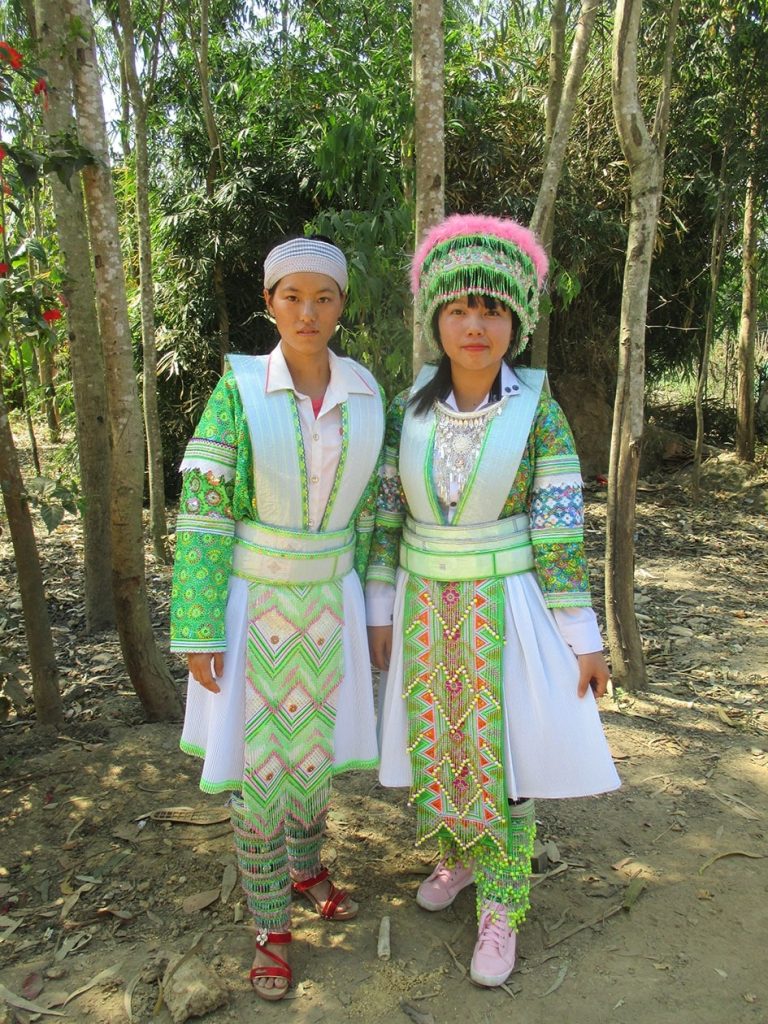
In contrast, Flower H’Mong brocade clothes are layered and vibrant. Women wear indigo skirts overlaid with red or green panels and wide, embroidered belts. Their jackets have high collars and open sides, often decorated with spiral motifs on the chest and shoulders. Headdresses range from rectangular embroidered cloths to wide circular wraps.
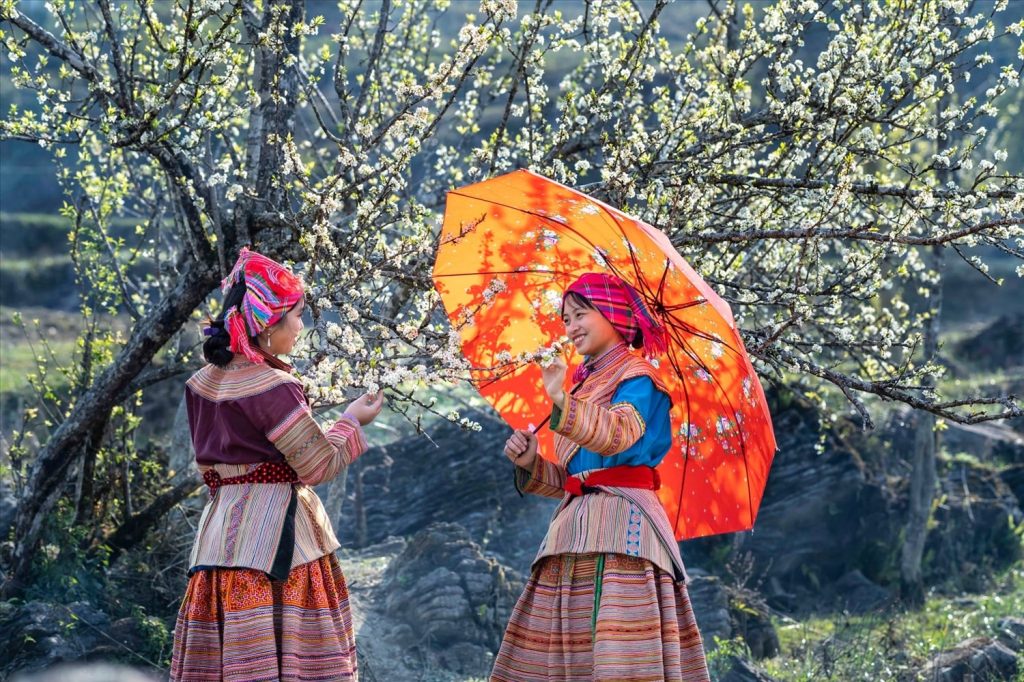
Black and Blue H’Mong, though less common in Ha Giang, bring their own variations. Black H’Mong favor deep indigo tones with minimal layering, while Blue H’Mong are known for aprons embroidered with leaf and zigzag motifs. These styles are mostly found in areas like Lai Chau or Bac Ha.
The Ultimate Ha Giang Loop Guide (2025): Itinerary, Map & Tips
2. Dao brocade clothes in Ha Giang: Sacred symbols in red, indigo, and silver
The Dao people account for over 14 percent of Ha Giang’s population, with communities spread across Hoang Su Phi, Quan Ba, Bac Me, and Quang Binh. Among them are four main subgroups: Red Dao, Dao Quan Trang, Dao Tien and Dao Ao Dai. Though they share language and spiritual roots, each group expresses its heritage through distinct brocade traditions tied to ancestry and ritual.
Red Dao brocade clothes are the most visually striking. Women wear long indigo robes detailed with red velvet yokes, silver buttons, and chestbands made of layered pom-poms. Their headdresses range from wrapped red scarves to wood-framed crowns adorned with coins and ritual embroidery. These are worn during weddings, New Year ceremonies, or ancestral offerings.
In Hoang Su Phi, Red Dao women retain a complete ceremonial costume, including double-layered scarves, embroidered yếm, silver jewelry, and leg wraps with red stitching. In Quan Ba, variations appear in floral sleeve patches and aprons, but the embroidered red chest panel remains a shared cultural symbol.
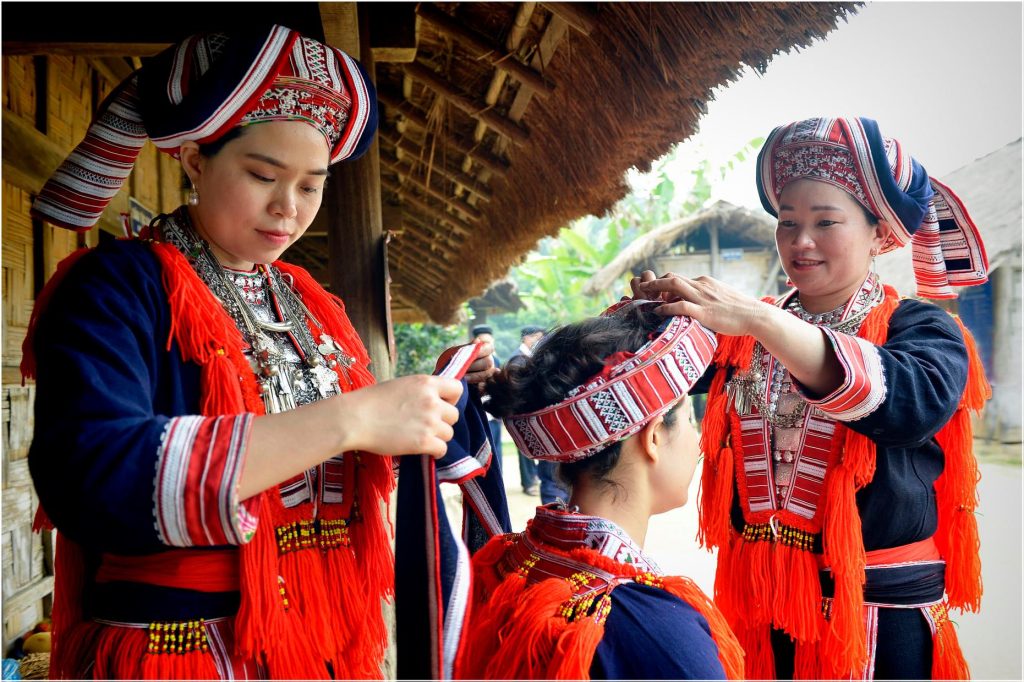
Dao Quan Trang women dress with elegance and clarity. Their outfit consists of a long indigo jacket and wide trousers, centered by a rectangular “yếm” embroidered with star, bird, and plant motifs. Each “yếm” is sewn entirely by hand, learned through years of mother-to-daughter transmission, and serves as a quiet reflection of skill and family upbringing.
Their headscarves are layered with care, and silver jewelry is kept modest. While less elaborate than Red Dao costumes, these garments carry deep cultural weight, often worn during weddings or spiritual rituals to express dignity and connection to community norms.
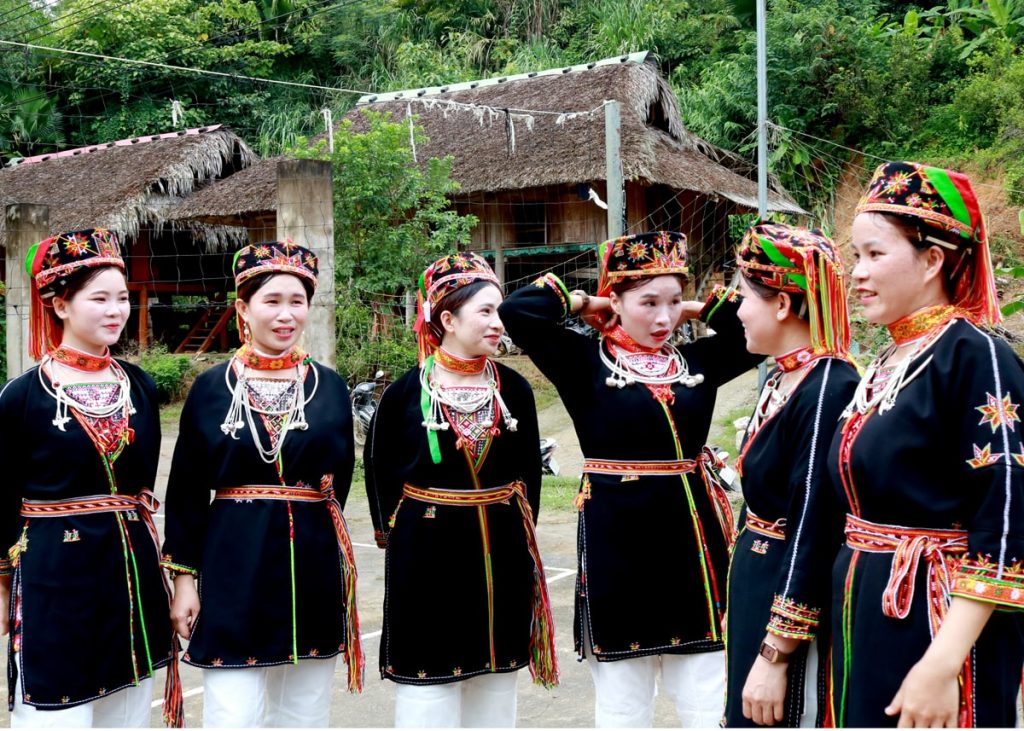
Dao Tien are unique among the Dao subgroups for wearing skirts instead of trousers. These skirts are decorated with beeswax batik patterns in soft blue tones, created through a traditional dye-resist method. A cloth belt ties the jacket, and silver coins stitched along the collar are believed to guard the spirit and honor ancestors.
Rather than emphasizing color or volume, Dao Tien clothing highlights technical skill and symbolic structure. Women spend weeks hand-stitching each garment. These outfits are reserved for important events such as Tet, weddings, or ancestral rites, where careful presentation reflects reverence.
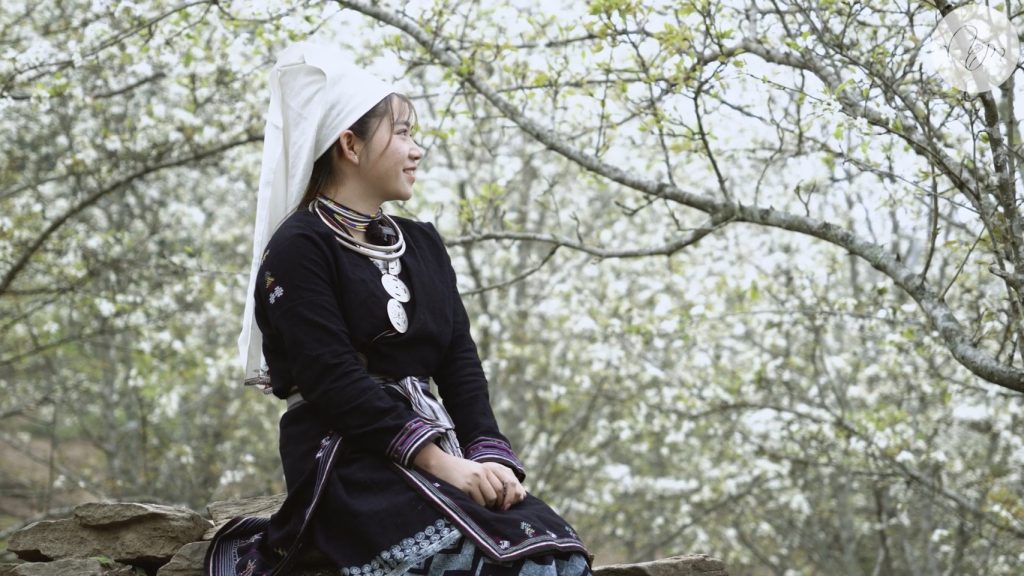
Dao Ao Dai women wear long, narrow robes with minimal surface embroidery, letting the headdress define their style. The crown-shaped headdress is wrapped in cloth and rimmed with engraved silver discs. A silver star sits at the center, representing harmony between the heavens and the earth. Hair is tightly wrapped beneath, reflecting quiet strength and maturity.
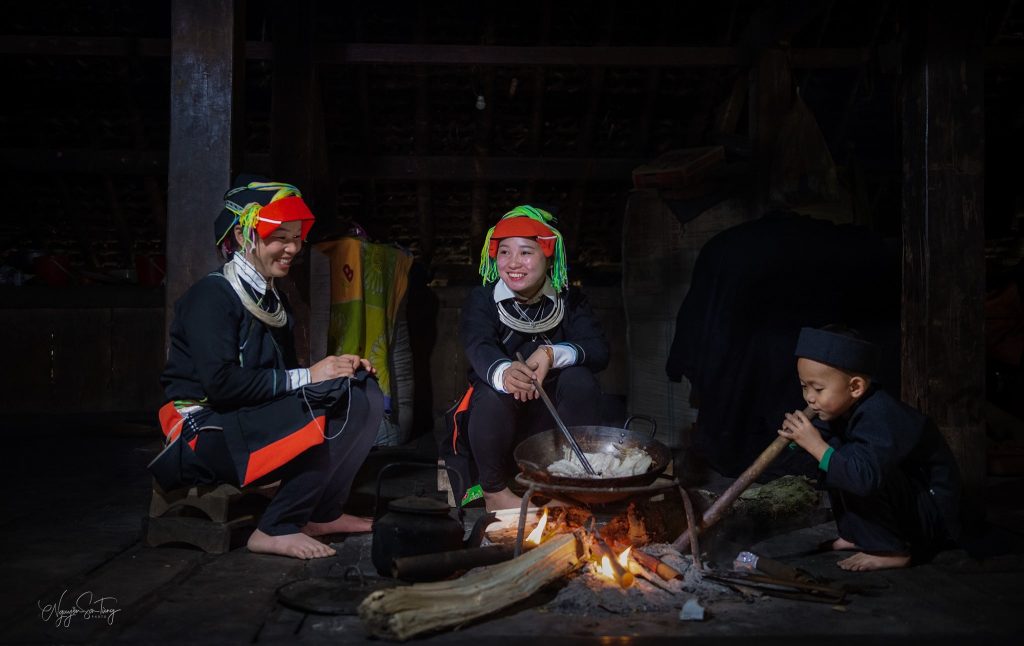
Across all four groups, brocade clothes are not simply garments. They are vessels of memory and meaning – stitched, worn, and passed on as a quiet testament to Dao identity and resilience in the highlands of Ha Giang.
Ha Giang in August: Weather, Things to Do & Travel Tips
3. Lo Lo traditional attire – Geometric motifs, layered patterns, color blocks
The Lo Lo are one of the oldest ethnic groups in Ha Giang, living primarily in Dong Van and Meo Vac. They are divided into two subgroups: Black Lo Lo (Lo Lo Den), who reside in Lung Cu, and Flower Lo Lo (Lo Lo Hoa), found in Lung Tao and Sung La. While they share a common ancestry, their traditional attire reflects distinct styles shaped by region, belief, and generational skill.
Lo Lo brocade clothes are renowned for its bold geometric motifs, intricate color blocks, and symbolic layering. Triangles appear frequently, symbolizing the ancient Lo Lo kingdom, while motifs of birds, corn, and buckwheat represent fertility, nature, and ancestral connection. Each pattern is handcrafted using needlework, patchwork, and a traditional batik technique, where beeswax is used to resist dye and reveal hidden designs.
Flower Lo Lo women wear vibrant, multi-layered outfits where meaning is embedded in detail. A girl who makes her own garment may embroider three motif bands on each sleeve, but if the clothing is a wedding gift from the groom’s family, it will feature four – a quiet symbol of craftsmanship, pride, and the family’s care. Rows of decorative buttons line the chest, arms and headdress, expressing community cohesion.
Young girls begin learning to sew at an early age, gradually acquiring the skill to make their own ceremonial outfits. Completing a full wedding costume can take three to four years. Each stitch reflects not only technical mastery but also cultural devotion passed down through generations.
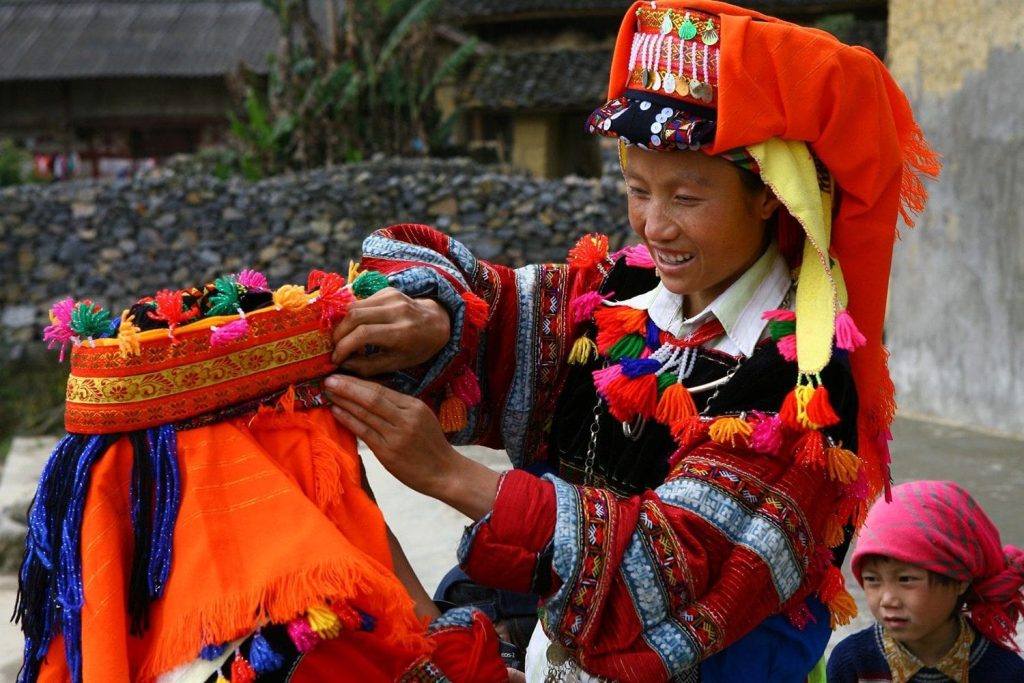
The Black Lo Lo dress in more subdued tones, typically deep indigo. Women wear short, open-front jackets and wide trousers, tightened with belts decorated with silver coins and charms. Their triple-layered headscarves, paired with handmade jewelry, add ceremonial elegance. Though less colorful than their Flower Lo Lo counterparts, their outfits emphasize symmetry, tradition, and restraint.
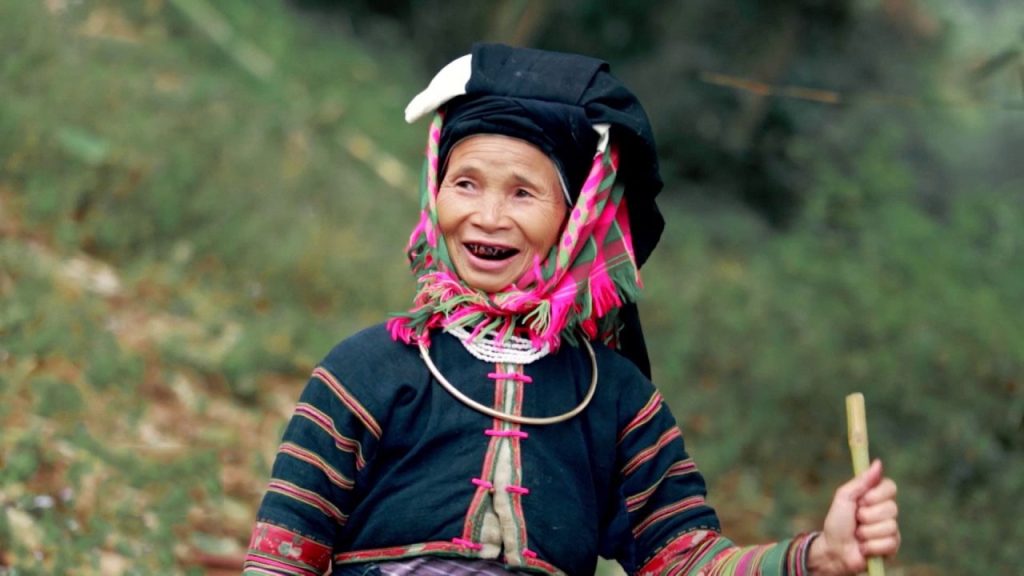
In Lo Lo villages like Lo Lo Chai, these garments are more than daily wear; they are cultural legacies. Despite economic and social change, the Lo Lo continue to uphold their textile heritage as a way of preserving identity, honoring ancestry, and maintaining cultural integrity within the broader Dong Van Karst Plateau community.
Lo Lo Chai and Lung Tao are frequent highlights on Phieu Travel’s Ha Giang Loop routes, where guests can interact with Lo Lo women, join embroidery sessions, and learn how each outfit tells a story of family, fertility, tradition.
Ha Giang’s Dao People: A Complete Guide to Their Culture and Festivals
4. Pa Then brocade clothes – Bright red, festival attire, handwoven symbols
The Pa Then people, primarily residing in Tan Bac commune, Quang Binh, Ha Giang, are known for their striking traditional attire, which carries deep cultural and spiritual significance. The dominant color in their clothing is red, symbolizing fire, light, and the sacred fire deity – elements central to their beliefs.
Pa Then women’s brocade clothes feature a rich combination of red with accents of black, white, green, and yellow. These colors are skillfully woven into symbolic patterns, including depictions of animals like dogs, water snakes, and human heads. Each motif represents their understanding of nature, the universe, and human life, serving as a visual expression of their worldview.
The garments are meticulously embroidered, a craft passed down through generations. This embroidery is not only a testament to the community’s technical skill but also to their cultural heritage and connection to their ancestors. The attire is often paired with silver jewelry, such as necklaces and bracelets, which adds elegance and a sense of pride in their cultural identity.
Traditionally, Pa Then women wear these brocade clothes during significant events such as weddings, New Year celebrations, and ancestral rites. These garments are more than just clothing; they are a powerful symbol of cultural pride, community bonds, and a deep-rooted connection to their heritage.
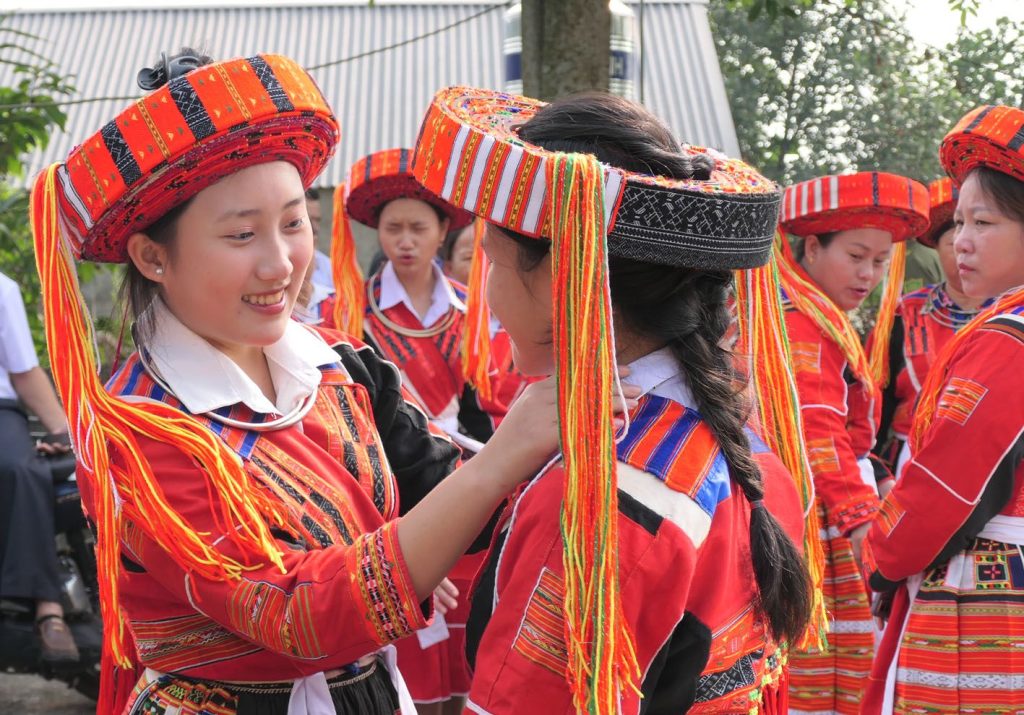
5. Giay brocade clothes – Soft colors, loose fit, subtle detailing
The Giay people, residing in the small village of Ma Lé in Dong Van, Ha Giang, are known for their elegant yet simple traditional attire. Women typically wear long, loose-fitting garments in soft colors like blue or black, secured with a cross-body closure, similar to the style worn by the Kinh people.
A defining feature of their brocade clothes are the sturdy waist belt made from dark fabric, which helps to support the body and can be used to carry tools like knives or ropes. This practical accessory adds structure while keeping the outfit comfortable and flexible.
The shoes worn by Giay women are especially beautiful, with intricate hand-embroidered patterns of butterflies, swans, or flowers. These delicate designs, which can take months to complete, showcase the skill and dedication of the women.
Giay women wear minimal jewelry, typically just a silver bracelet or necklace, reflecting their appreciation for simplicity and understated beauty. A colorful headscarf, worn in a hoop style, adds a vibrant touch to their outfit.
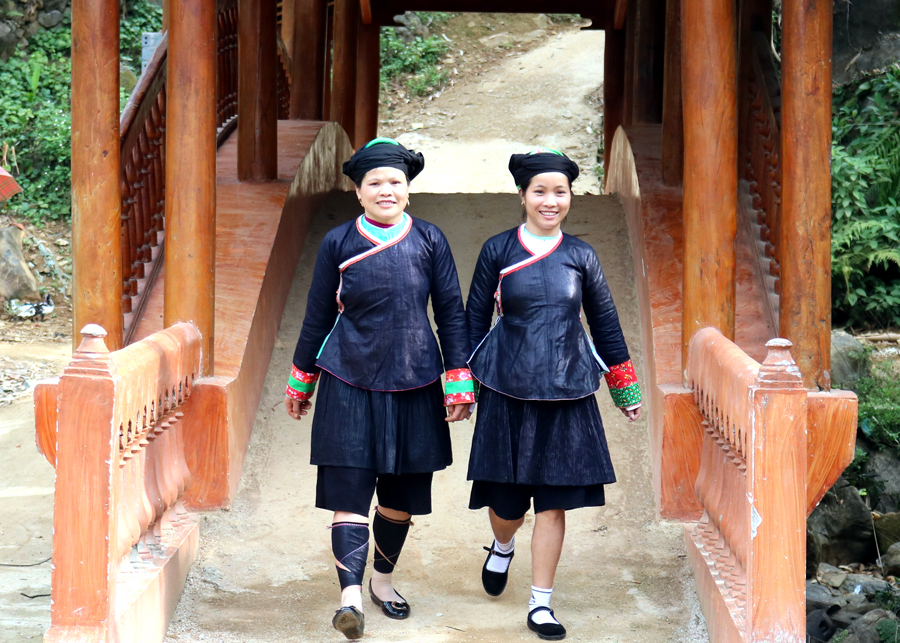
6. Nung brocade clothes – Indigo tunics, simple elegance, traditional headwraps
The Nung people have lived in Ha Giang for around 300 years, primarily in narrow valleys within Quan Ba and Yen Minh districts of Dong Van Karst Plateau UNESCO Global Geopark. Their traditional attire is characterized by simple yet elegant indigo-colored clothing.
Nung women typically wear a five-panel tunic (pu) reaching knee-length, buttoned at the right armpit with contrasting green cuffs. Except for Nung Din bridal attire – decorated with intricate embroidery and silver beads—daily outfits remain minimalistic and free of elaborate patterns.
Most Nung women wear loose black pants they sew themselves, often featuring a waistband made of white or differently colored fabric. The Nung Din subgroup uniquely wears layered wrap skirts, which they conveniently tuck upward at the back while working.
Traditional headwraps are black square scarves tied in a raven’s-beak style. However, Nung Din women have two distinct headwraps: an everyday version (pau pa) and a ceremonial version (chau chip) decorated with vibrant embroidered motifs.
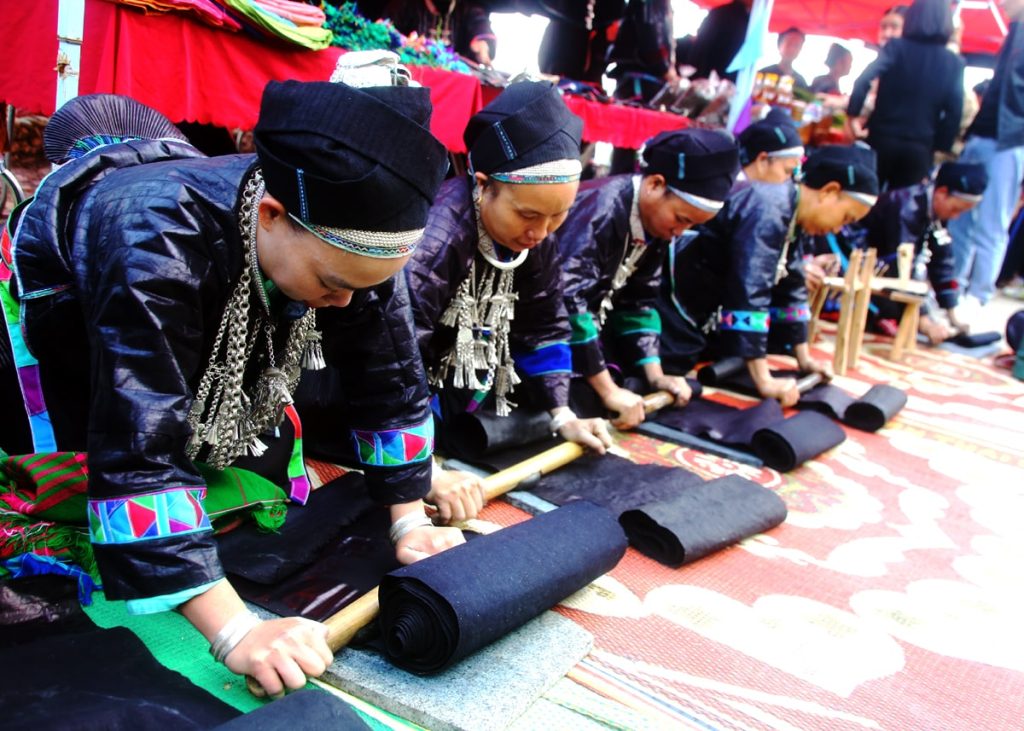
Discovering the beauty of brocade clothes across Ha Giang brings you closer to the stories and traditions of its ethnic communities. By choosing a journey with Phieutravel.com, you’ll meet local artisans, witness firsthand the dedication behind each handmade garment, and gain authentic cultural insights. Contact us today to start your unforgettable journey!
Read more:
- Ha Giang travel route map updated after the July 1, 2025 merger
- Dong Van Karst Plateau Travel: What to Do, When to Go and Must-Visit Places
- The Best Time to Visit Ha Giang: A Seasonal Guide to Flowers & Festivals

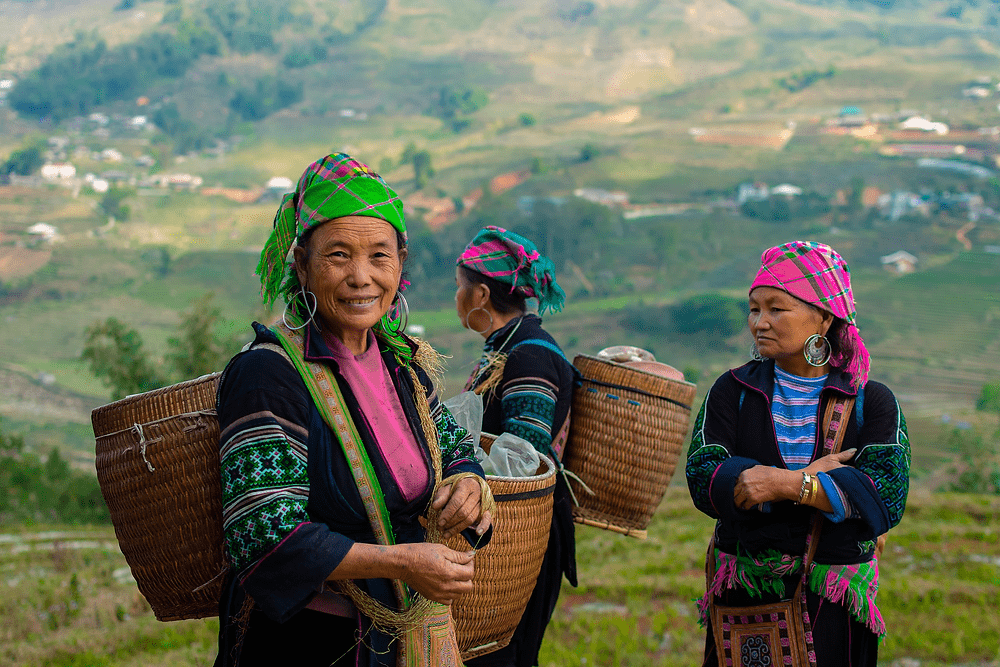
You Might Also Like
Ha Giang Weather in September: Complete Guide for Travelers
Exploring the magnificent Ha Giang Loop in September offers travelers a perfect balance of favorable[...]
Quan Ba Twin Mountains: Ha Giang’s Iconic Fairy Hills and Complete Travel Guide
The mystical Quan Ba Twin Mountains rise from the emerald valleys of Ha Giang like[...]
Vuong family mansion: the architectural marvel and cultural legacy of Ha Giang
Deep in Vietnam’s northern highlands, where mist-shrouded mountains meet terraced rice fields, stands a testament[...]
Ha Giang Loop Safety Tips: How to Ride Securely in Vietnam’s Northern Mountains
The Ha Giang Loop, with its winding mountain roads and breathtaking landscapes, offers one of[...]
The Ultimate Guide to the M-Shaped Curve on Ha Giang Loop
Vietnam’s remote northern province of Ha Giang hides a natural wonder that has captivated adventurous[...]
Most Beautiful Places to Visit in Vietnam: Essential Destinations and Insider Tips
Vietnam captivates travelers with its stunning landscapes, rich cultural heritage, and warm hospitality. From mist-shrouded[...]
Beyond the Beaten Path: Discovering Ha Giang Province in Northeast Vietnam
Ha Giang Province in Northeast Vietnam stands as one of the country’s last frontiers for[...]
Rainy season in Ha Giang: what to expect, when to go, and travel tips
Vietnam’s northern frontier reveals a different face during the rainy season, transforming Ha Giang’s limestone[...]